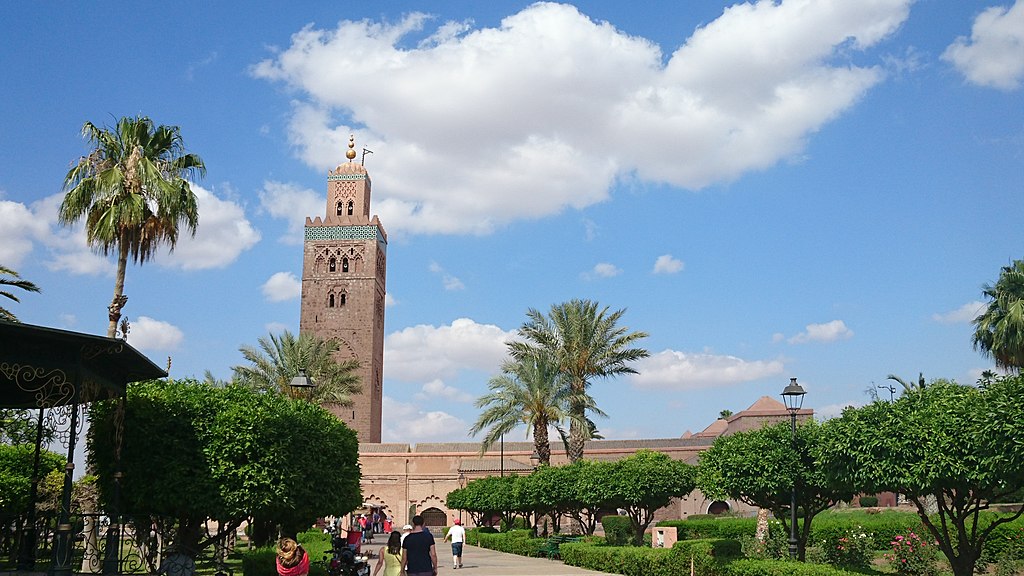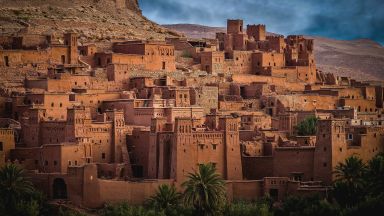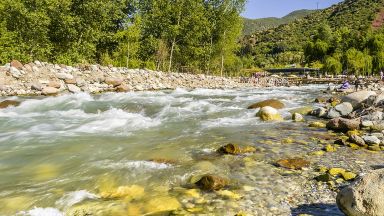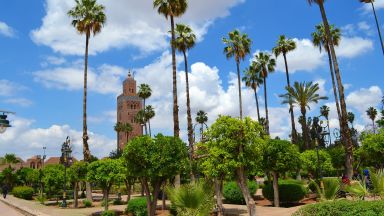Self Guided Walking Tour of Marrakesh (with photos and a map)
This website uses affiliate links which earn a small commission at no additional cost to you.
Marrakesh has it all colourful souks, Moorish architecture, intimate gardens and boutique hotels. This self guided tour will take you from the quiet courtyards and snaking alleyways of the historic Medina, alongside stunning palaces leading to the 12th century Koutoubia Mosque.
Jemaa el-Fnaa
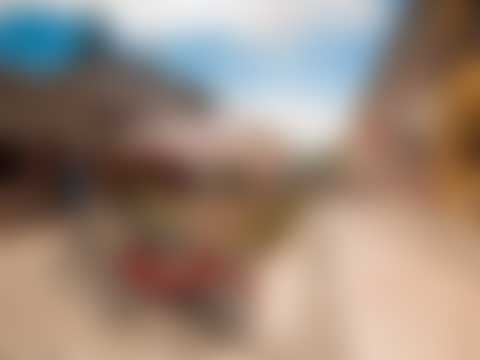
Jemaa el-Fnaa is a great place to start our tour. Look for the Minaret de la Koutoubia in the west. You will use this to orient yourself if you get lost!
The Jemaa el-Fnaa is Marrakech’s main square and the most important part of the medina. Jemaa el-Fna is the city’s top attraction and can be visited at all hours of the day. At this fascinating spot, you’ll find snake charmers, the magical souk, monkeys and henna artists. The best view of Jemaa el Fna is from one of the roof terraces framing the edge of the square. Look for Le Grand Balcon du Café Glace – it is perfectly positioned to witness the full scale of the activity on the square below.
Location: Jemaa el-Fnaa, Rue des Banques, Marrakesh, Morocco
Read more about Jemaa el-Fnaa
Musee Dar Si Said

Leave the square by the eastern road (away from the Minaret de la Koutoubia), turn right onto Rue Riad Zitoun el Jdid by the restaurant Marrakchi. About halfway down this street (by the Herboristerie La Musée – avoid this place), you nee to turn left – you may need to ask for directions or find the sign posts for the Musee Dar Si Said.
The Musée Dar Si Saïd, also known as the Museum of Moroccan Art, is housed in a stunning palace in Marrakech. The palace was built in the mid 19th century for Si Saïd ibn Moussa, the Minister of War, and boasts a beautiful courtyard with flowers, cypress trees, a gazebo, and a fountain. The exhibition rooms surrounding the courtyard are adorned with intricately carved doors, intricate stucco work, and mosaics, as well as a domed reception room and harem quarters.
The museum’s collection is highly regarded and includes jewellery from various regions in Morocco, carpets, oil lamps, pottery, and leather work. A standout piece in the collection is a 10th-century Spanish marble basin, which was brought to Marrakech by Sultan Ali ben Youssef in 1120 and initially placed in a mosque despite its depiction of an eagle and griffons, which goes against Islamic law. The basin was later moved to the Ben Youssef Madrasa and eventually donated to the museum after the college’s restoration.
Location: Dar Si Said, Rue de la Bahia, Marrakesh, Morocco | Hours: Daily 9 am to 12 pm and 3 pm to 6 pm | Price: General: 70 dh (US$ 6.70)
Read more about Dar Si Said
Bahia Palace

Head south from the Musée Dar Si Saïd, turn right onto Rue de la Bahia. You should pass the Tiskiwin Museum on your right. You shoudl turn left onto Rue Riad Zitoun el Jdid, at the end of which is theentrance to the Bahia Palace.
The Bahia Palace, also known as the “Palace of the Brilliant/Beautiful,” is a stunning late 19th century palace that spans 8 hectares, including a garden. Located close to the royal El Badi Palace and about 900 meters southeast of Jemaa el-Fnaa, the Bahia Palace is an oasis of calm in the midst of the bustling medina souk and offers a respite from the noise of traffic. The complex features 150 rooms, patios, courtyards, fountains, and gardens, and is adorned with intricate tile work, mosaics, coloured glass, carvings, and elaborate ceilings.
Originally built for Si Moussa, the Grand Vizier of Sultan Hassan I, the Bahia Palace was the largest and most luxurious palace in Morocco at the time. During the French Protectorate, it was the residence of General Hubert Lyautey, who added electricity, fireplaces, and heating. Although the rooms are not furnished with period furniture, the tiled walls and ceilings more than make up for it. Visitors can explore the palace in about 30 minutes, but it is also enjoyable to spend more time taking in all of the details of the palace.
Location: Bahia Palace, Rue Riad Zitoun el Jdid, Marrakesh, Morocco | Hours: Friday: 8am to 5pm Rest of the week: 9am to 4:30pm. | Price: adult/child Dh70/30
Read more about Bahia Palace
El Badi Palace

From the Badia Palace head west and you will soon find yourself in the Place des Ferblantiers,a palm-lined square in the Mellah with artisans selling handcrafted tin lamps & housewares. People will probably approach you to tell you that the Badi palace is closed for lunch, but that is not the case. Don’t listen to them, the palace is open non-stop all day!Leave the square to the south through the archway. Turn right onto Rue de Berrima.
The El Badi Palace, also known as the “Incomparable Palace,” was once a grand and stately palace but now stands in ruins. Commissioned by Sultan Ahmed el-Massour of the Saadian Dynasty in 1572 to celebrate his victory over the Portuguese in the Battle of the Three Kings, the El Badi Palace was intended to be the most impressive building in Marrakech. However, the sultan died before the palace was completed in 1603.
The El Badi Palace was a massive complex with 360 rooms surrounding an interior courtyard that measured 135 meters by 110 meters and featured fountains and a large pond. The palace was funded using reparation debt imposed on Portugal after the battle and was decorated with mosaics from Italy, gold fittings from the gold mines of Sudan, and onyx, ivory, cedar wood, and semi-precious stones.
After the Saadian Dynasty fell to the Alaouites in 1683, Sultan Moulay Ismail stripped the El Badi Palace of its valuable decorations to use in his new palace in another town, and the El Badi Palace slowly fell into ruin. Visitors can explore the ruins of the palace and climb an internal staircase on the northeast side to a small terrace with a view of the complex. The palace also houses a small museum containing a restored 12th-century carved minbar (Imam’s pulpit) from the nearby Koutoubia Mosque.
Location: Badi Palace, Ksibat Nhass, Marrakesh, Morocco | Hours: 9am-5pm | Price: adult/child Dh70/30 | Website
Read more about Badi Palace
Saadian Tombs

Continue along the Rue de Berrima to the Saadian Tombs.
The Saadian Tombs, located in the Kasbah of the royal district in the medina of Marrakech, offer a glimpse into the beauty of ancient Morocco. The tombs were commissioned by Sultan Ahmed Al-Mansur of the Saadian dynasty in 1554 for himself and his family, and are the only surviving remnants of the dynasty’s reign, which lasted from 1554 to 1659. When the dynasty fell to the Alaouites, the new sultan attempted to destroy all evidence of the Saadians’ rule, but spared the tombs, which were partially sealed off (although important individuals were still buried there until 1792).
The Saadian Tombs are incredibly well-preserved due to their partial sealing and protection from external elements. The “Hall of the Twelve Columns,” where Al-Mansur and 60 members of the Saadian family are entombed, is adorned with imported Italian marble, intricate tile work, gilded honeycomb muqarnas, and elaborate, detailed and colorful ceilings. The “Hall of the Three Niches” houses important princes, while approximately 170 chancellors and their wives are buried in the garden.
The tombs were discovered in 1917 through aerial photography and were lovingly restored by the French organization, the Beaux-Arts Service. The tombs offer a peaceful resting place for those interred within.
Location: Saadien's Tombs, Rue de La Kasbah, Marrakesh, Morocco | Hours: 9am-5pm | Price: adult/child Dh70/30
Read more about Saadian Tombs
Kasbah Mosque

The Kasbah Mosque is one of the oldest and largest mosques in Marrakech, having been built in 1190. It is the second-best-known mosque in the city after the Koutoubia Mosque and features typical Almohad architecture. The mosque opens onto a square surrounded by interesting buildings and has a distinct minaret, which served as a prototype for many later minarets in the Maghreb and al-Andalus and is decorated differently from the minaret of the Koutoubia Mosque. The exterior of the mosque is imposing, with high walls topped by merlons above a row of corbels and large pointed horseshoe arches, some of which are now walled-in, while others frame the gates of the mosque or house shops.
The Kasbah Mosque has undergone multiple restorations and is now in excellent condition. It is an active place of worship, with the call to prayer drawing in hundreds of worshipers daily (although it has the capacity to accommodate many thousands more). Non-Muslims are not permitted to enter the mosque, but it is still enjoyable to sit outside and take in the atmosphere. The area around the mosque is quieter and more open than other parts of the medina, and there are several nice cafes where visitors can sit and appreciate the surrounding architecture.
Location: Koutoubia, جامع الكتبية،، Avenue Mohammed V،، Marrakesh, Morocco
Read more about Kasbah Mosque
Bab Agnaou & the Walls of Marrakech

Bab Agnaou, located in the southwest corner of Marrakech, is one of the 19 huge gates that once guarded entry into the city as part of its protective walls. It is the most noteworthy of the surviving gates, with rich decoration reflecting the 12th-century fortification design and embellishments. At one point, the gate served as an entrance to the El Badi Palace, home to the royal family, and was more of a decorative feature than a defensive one.
The entryway of the Bab Agnaou gate is a large horseshoe arch with concentric circles of symmetrical carvings – four semi-circular carved arcs, one above the other, with geometric floral patterns and a frieze along the top inscribed with verses from the Koran in Kufic lettering. The gate is constructed of Gueliz sandstone, which gives it its blue/ochre color. The two broken areas at each end of the top suggest that two slender towers once stood in this location, which may be the source of the gate’s name, “Agnaou,” which means “sheep without horns” in ancient Berber.
Today, the Bab Agnaou gate is a popular photo opportunity in the old city of Marrakech, a UNESCO World Heritage Site.
Location: Bab Agnaou, Marrakesh, Morocco
Read more about Walls of Marrakesh
Koutoubia Gardens (Lalla Hassna Park)

From Bab Agnaou head north to see Lalla Hasna Park and the Koutoubia Mosque.
Lalla Hasna Park is a pretty garden just west of the Koutoubia. Laid out with pools, roses, palms and orange trees. it’s the prefect place to stroll or sit while enjoying views of the mosque.
Location: Parc Lalla Hasna, Marrakesh, Morocco | Hours: Daylight Hours | Price: Free
Read more about Koutoubia Gardens (Lalla Hassna Park)
Koutoubia Mosque

The Koutoubia Mosque and minaret, located 200 meters west of Jemaa el-Fnaa on Avenue Mohammed V, is the largest mosque in Marrakech and serves as a useful landmark for orienting oneself within the medina’s labyrinth. The mosque’s name, “Koutoubia,” is derived from the Arabic “al-Koutoubiyyin,” which means “bookseller,” as the area was once home to many sellers of books and manuscripts. The mosque is closed to non-Muslims, but everyone can enjoy the adjacent park, which features trees (palms, orange, olives), flower beds, fountains, and benches, at all times for free.
A smaller predecessor mosque was built on this site in 1147 by the Almohad dynasty after they defeated the Almoravides and took control of Marrakech. However, the qiblah wall of the mosque, which should have faced Mecca, was incorrectly oriented, so instead of correcting its position, the Almohades built a new, larger mosque nearby and the old one fell into disuse. The current mosque is constructed of reddish-brown sandstone and is decorated with curved window arches and pointed “merlons” or crenellations.
The Koutoubia’s minaret is a square structure that stands 69 meters high and 13 meters wide, with six rooms stacked on top of one another and crowned with a ceramic strip, small tower, and four gilded copper balls decreasing in size. The north-western side of the minaret contains ruins and cisterns from an Almoravid palace that stood on the site before the Almohades took over.
Location: Koutoubia Mosque, جامع الكتبية،، Avenue Mohammed V،، Marrakesh, Morocco | Hours: Non-Muslims can’t go inside the Koutoubia Mosque or minaret but are most likely to get a glimpse inside on a Friday when the doors are open for prayers.
Read more about Koutoubia Mosque
This website uses affiliate links which earn a small commission at no additional cost to you.
